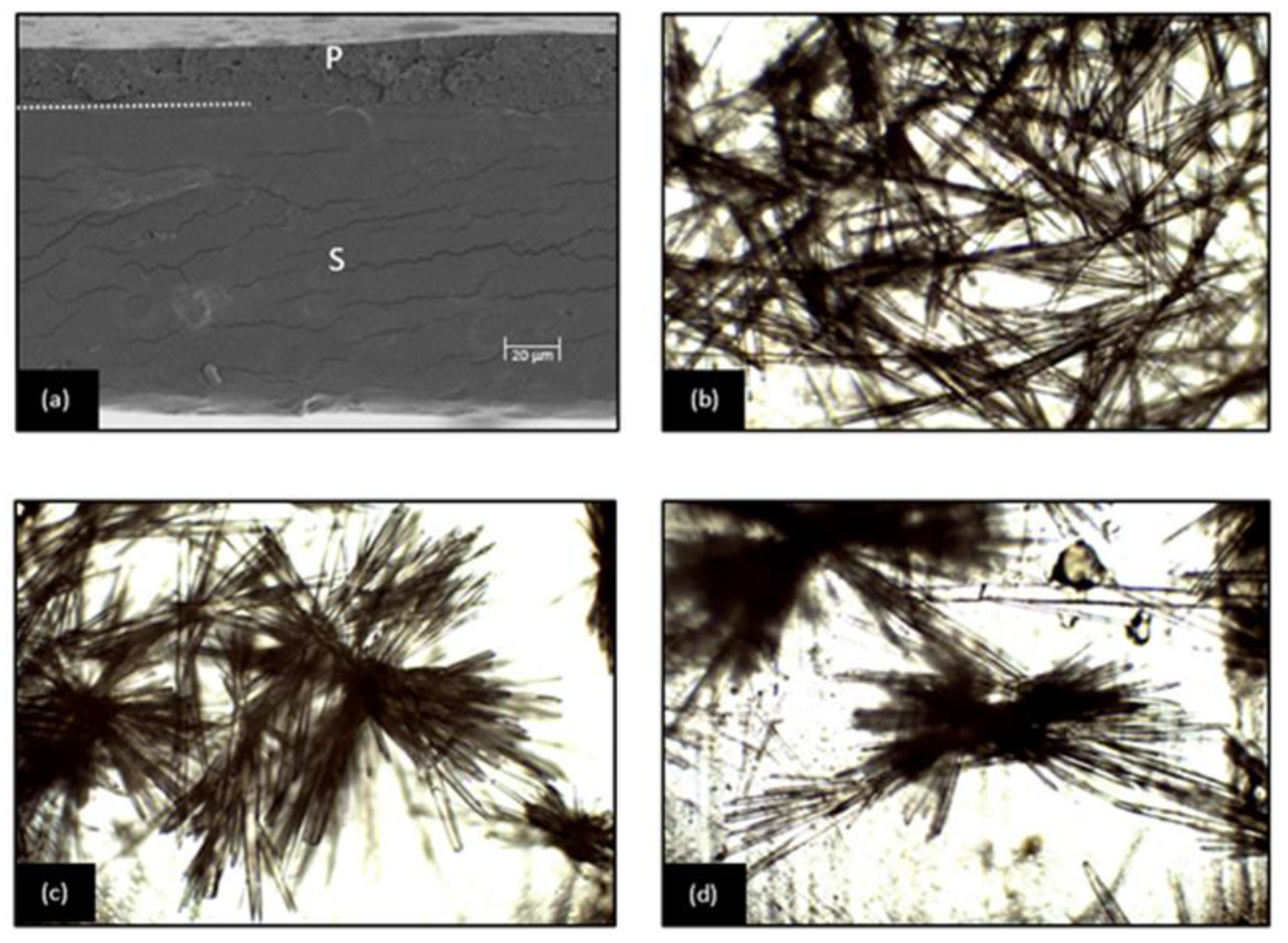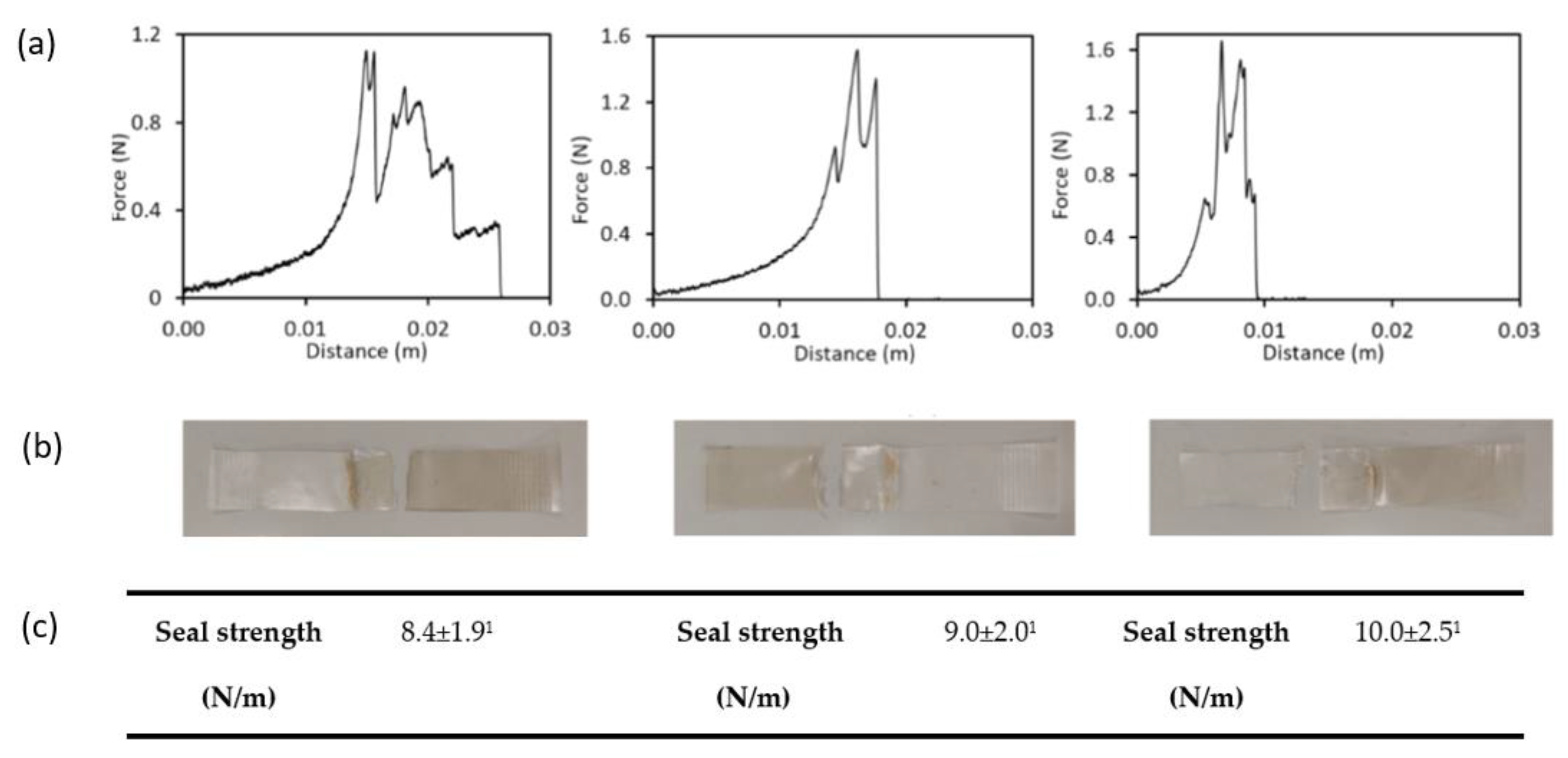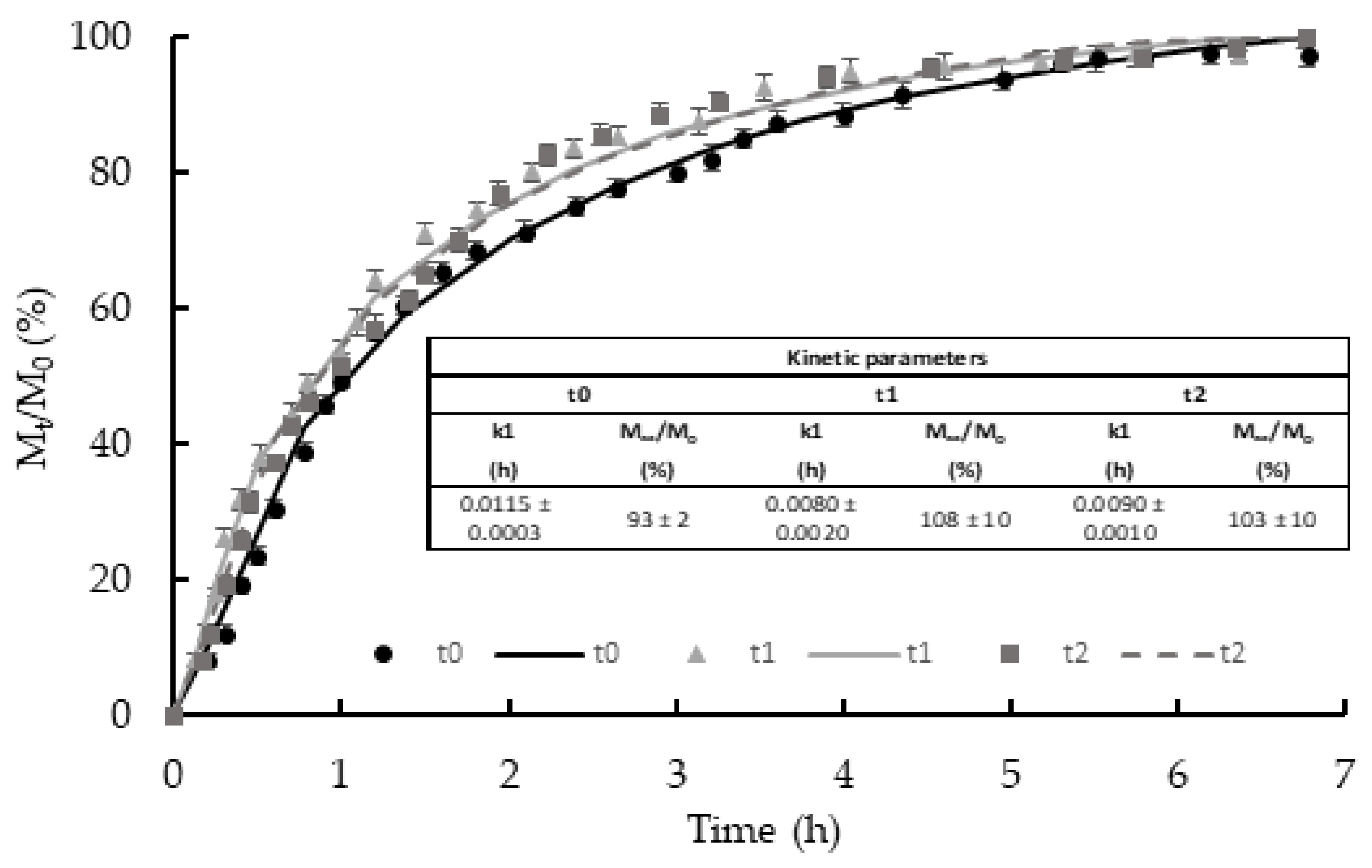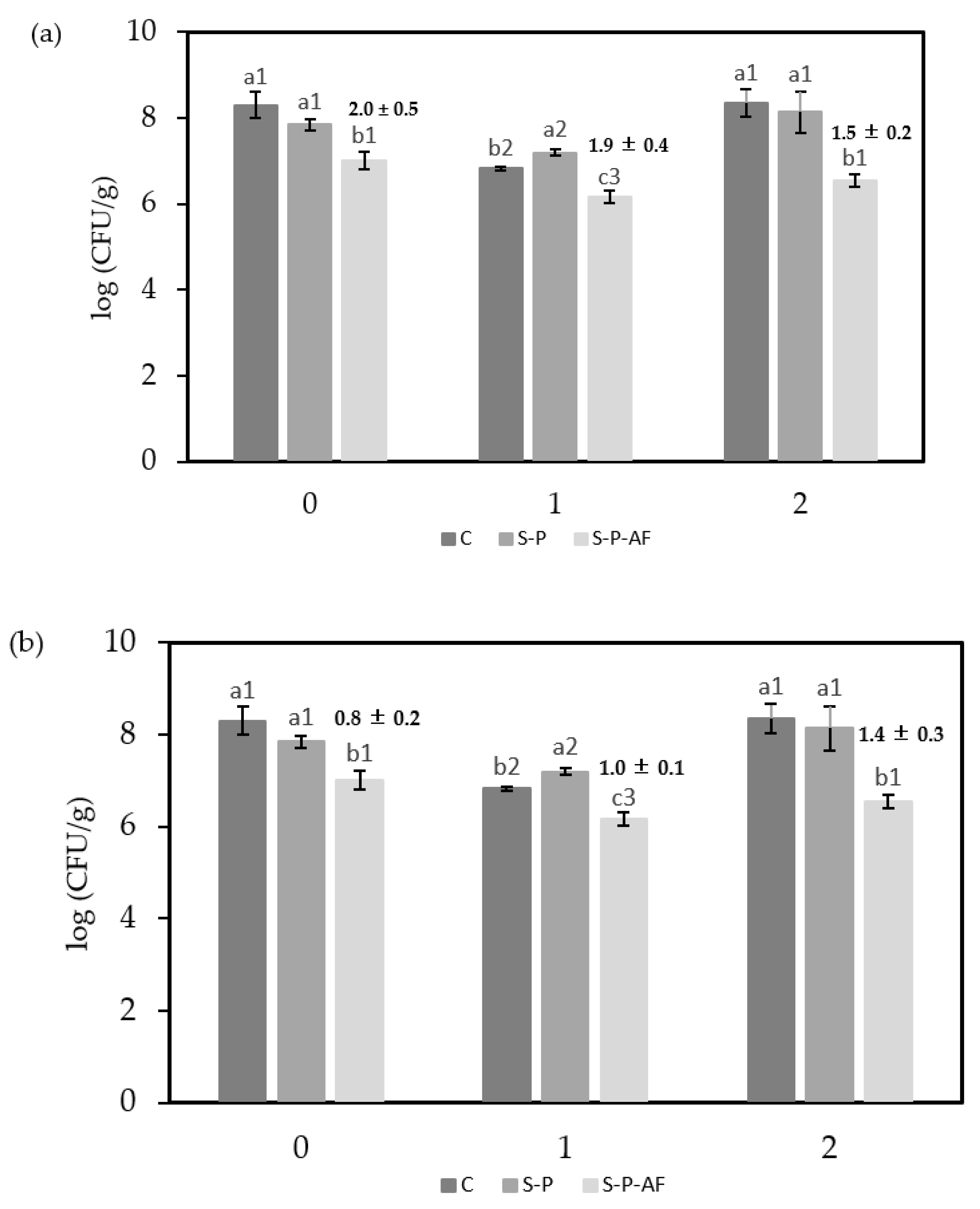Active Starch-Polyester Bilayer Films with Surface-Incorporated Ferulic Acid
Abstract
1. Introduction
2. Materials and Methods
2.1. Materials
2.2. Preparation of Bilayer Films
2.3. Superficial Incorporation of Active Solution
2.4. Microstructural Analyses
2.5. Tensile and Barrier Properties
2.6. Release Kinetics of Ferulic Acid from the Film in Aqueous Media
2.7. Antioxidant Activity
2.8. Characterization of the Seal Strength in Bilayers
2.9. Antibacterial Activity Assessment
2.10. Statistical Analysis
3. Results and Discussion
3.1. Load and Structure of Ferulic Acid onto the Films
3.2. Tensile and Barrier Properties of the Bilayers and their Stability throughout Storage
3.3. Stability of the Bilayer Thermo-Sealing
3.4. Stability of Superficially Incorporated Ferulic Acid and Antioxidant and Antimicrobial Properties of the Films
4. Conclusions
Author Contributions
Funding
Institutional Review Board Statement
Informed Consent Statement
Data Availability Statement
Conflicts of Interest
References
- Hernández-García, E.; Vargas, M.; Chiralt, A. Thermoprocessed starch-polyester bilayer films as affected by the addition of gellan or xanthan gum. Food Hydrocoll. 2021, 113, 106509. [Google Scholar] [CrossRef]
- Muller, J.; González-Martínez, C.; Chiralt, A. Combination of Poly(lactic) acid and starch for biodegradable food packaging. Materials 2017, 10, 952. [Google Scholar] [CrossRef] [PubMed]
- Hernández-García, E.; Vargas, M.; Torres-Giner, S. Quality and Shelf-Life Stability of Pork Meat Fillets Packaged in Multilayer Polylactide Films. Foods 2022, 11, 426. [Google Scholar] [CrossRef] [PubMed]
- Sadasivuni, K.K.; Saha, P.; Adhikari, J.; Deshmukh, K.; Ahamed, M.B.; Cabibihan, J.J. Recent advances in mechanical properties of biopolymer composites: A review. Polym. Compos. 2020, 41, 32–59. [Google Scholar] [CrossRef]
- Wang, Q.; Chen, W.; Zhu, W.; McClements, D.J.; Liu, X.; Liu, F. A review of multilayer and composite films and coatings for active biodegradable packaging. npj Sci. Food 2022, 6, 18. [Google Scholar] [CrossRef]
- Anukiruthika, T.; Sethupathy, P.; Wilson, A.; Kashampur, K.; Moses, J.A.; Anandharamakrishnan, C. Multilayer packaging: Advances in preparation techniques and emerging food applications. Compr. Rev. Food Sci. Food Saf. 2020, 19, 1156–1186. [Google Scholar] [CrossRef]
- Wu, F.; Misra, M.; Mohanty, A.K. Challenges and new opportunities on barrier performance of biodegradable polymers for sustainable packaging. Prog. Polym. Sci. 2021, 117, 101395. [Google Scholar] [CrossRef]
- Wang, L.; Shogren, R.L.; Carriere, C. Preparation and properties of thermoplastic starch-polyester laminate sheets by coextrusion. Polym. Eng. Sci. 2000, 40, 499–506. [Google Scholar] [CrossRef]
- Olivato, J.B.; Grossmann, M.V.E.; Bilck, A.P.; Yamashita, F.; Oliveira, L.M. Starch/polyester films: Simultaneous optimisation of the properties for the production of biodegradable plastic bags. Polímeros 2013, 23, 32–36. [Google Scholar] [CrossRef]
- Ordoñez, R.; Atarés, L.; Chiralt, A. Biodegradable active materials containing phenolic acids for food packaging applications. Compr. Rev. Food Sci. Food Saf. 2022, 21, 3910–3930. [Google Scholar] [CrossRef]
- Requena, R.; Vargas, M.; Chiralt, A. Eugenol and carvacrol migration from PHBV films and antibacterial action in different food matrices. Food Chem. 2019, 277, 38–45. [Google Scholar] [CrossRef] [PubMed]
- Itagaki, S.; Kurokawa Nakata, T.C.; Saito, Y.; Oikawa, S.; Kobayashi, M.; Hirano, T.; Iseki, K. In vitro and in vivo antioxidant properties of ferulic acid: A comparative study with other natural oxidation inhibitors. Food Chem. 2009, 114, 466–471. [Google Scholar] [CrossRef]
- Zduńska, K.; Dana, A.; Kolodziejczak, A.; Rotsztejn, H. Antioxidant properties of ferulic acid and its possible application. Skin Pharmacol. Physiol. 2018, 31, 332–336. [Google Scholar] [CrossRef] [PubMed]
- Miyague, L.; Macedo, R.E.F.; Meca, G.; Holley, R.A.; Luciano, F.B. Combination of phenolic acids and essential oils against Listeria monocytogenes. Food Sci. Technol. 2015, 64, 333. [Google Scholar] [CrossRef]
- Pernin, A.; Bosc, V.; Maillard, M.-N.; Dubois-Brissonnet, F. Ferulic acid and eugenol have different abilities to maintain their inhibitory activity against Listeria monocytogenes in emulsified systems. Front. Microbiol. 2019, 10, 137. [Google Scholar] [CrossRef]
- Ordoñez, R.; Atarés, L.; Chiralt, A. Effect of ferulic and cinnamic acids on the functional and antimicrobial properties in thermo-processed PLA films. Food Packag. Shelf Life 2022, 33, 100882. [Google Scholar] [CrossRef]
- Ordoñez, R.; Atarés, L.; Chiralt, A. Antibacterial properties of cinnamic and ferulic acids incorporated into starch and PLA monolayer and multilayer films. Food Control 2022, 136, 108878. [Google Scholar] [CrossRef]
- Hernández-García, E.; Vargas, M.; Chiralt, A. Effect of active phenolic acids on properties of PLA-PHBV blend films. Food Packag. Shelf Life 2022, 33, 100894. [Google Scholar] [CrossRef]
- Hernández-García, E.; Vargas, M.; Chiralt, A. Starch-polyester bilayer films with phenolic acids for pork meat preservation. Food Chem. 2022, 385, 132650. [Google Scholar] [CrossRef]
- Ordoñez, R.; Atarés, L.; Chiralt, A. Antilisterial action of PLA films with ferulic acid as affected by the method of incorporation. Food Biosci. 2022, 49, 101865. [Google Scholar] [CrossRef]
- D882; Standard Test Method for Tensile Properties of Thin Plastic Sheeting. Annual Book of ASTM Standards. American Society for Testing and Materials: Philadelphia, PA, USA, 2001; pp. 162–170.
- Requena, R.; Vargas, M.; Chiralt, A. Obtaining antimicrobial bilayer starch and polyester-blend films with carvacrol. Food Hydrocoll. 2018, 83, 118–133. [Google Scholar] [CrossRef]
- D3985-05; Standard Test Method for Oxygen Gas Transmission Rate through Plastic Film and Sheeting using a Coulometric Sensor. Annual Book of ASTM Standards. American Society for Testing and Materials: Philadelphia, PA, USA, 2010; pp. 1–7.
- E96–95; Standard Test Methods for Water Vapor Transmission of Materials. ASTM, Annual Book of ASTM Standards. American Society for Testing and Materials: Philadelphia, PA, USA, 1995; pp. 406–413.
- McHugh, T.H.; Avena-Bustillos, R.; Krochta, J.M. Hydrophobic edible films: Modified procedure for water vapour permeability and explanation of thickness effects. J. Food Sci. 1993, 58, 899–903. [Google Scholar] [CrossRef]
- Ortega-Toro, R.; Morey, I.; Talens, P.; Chiralt, A. Active bilayer films of thermoplastic starch and polycaprolactone obtained by compression molding. Carbohydr. Polym. 2015, 127, 282–290. [Google Scholar] [CrossRef] [PubMed]
- Peleg, M. An empirical model for the description of moisture sorption curves. J. Food Sci. 1988, 53, 1216–1217. [Google Scholar] [CrossRef]
- Brand-Williams, W.; Cuvelier, M.E.; Berset, C. Use of a free radical method to evaluate antioxidant activity. Food Sci. Technol. 1995, 28, 25–30. [Google Scholar] [CrossRef]
- Ozcelik, B.; Lee, J.H.; Min, D.B. Effects of light, oxygen, and pH on the absorbance of 2, 2-diphenyl-1-picrylhydrazyl. J. Food Sci. 2003, 68, 487–490. [Google Scholar] [CrossRef]
- F88/F88M-15; Standard Test Methods for Seal Strength of Flexible Barrier Materials. ASTM, Annual Book of ASTM Standards. American Society for Testing and Materials: Philadelphia, PA, USA, 2015.
- Valencia-Sullca, C.; Vargas, M.; Atarés, L.; Chiralt, A. Thermoplastic cassava starch-chitosan bilayer films containing essential oils. Food Hydrocoll. 2017, 75, 107–115. [Google Scholar] [CrossRef]
- Chen, H.; Wang, C.; Kang, H.; Zhi, B.; Haynes, C.L.; Aburub, A.; Sun, C.C. Microstructures and pharmaceutical properties of ferulic acid agglomerates prepared by different spherical crystallization methods. Int. J. Pharm. 2020, 574, 118914. [Google Scholar] [CrossRef]
- Urbaniak-Domagala, W. Electrical properties of polylactides. J. Electrostat. 2013, 71, 456–461. [Google Scholar] [CrossRef]
- Batista, R.S.D.A.; Melo, T.B.L.; dos Santos, J.A.B.; de Andrade, F.H.D.; Macedo, R.O.; de Souza, F.S. Evaluation of crystallization technique relating to the physicochemical properties of cinnamic acid. J. Therm. Anal. Calorim. 2019, 138, 3727–3735. [Google Scholar] [CrossRef]
- Zhang, X.X.; Yang, Z.J.; Nie, F.; Yan, Q.L. Recent advances on the crystallization engineering of energetic materials. Energetic Mater. Front. 2020, 1, 141–156. [Google Scholar] [CrossRef]
- Cano, A.; Jiménez, A.; Cháfer, M.; Gónzalez, C.; Chiralt, A. Effect of amylose: Amylopectin ratio and rice bran addition on starch films properties. Carbohydr. Polym. 2014, 111, 543–555. [Google Scholar] [CrossRef]
- Farah, S.; Anderson, D.G.; Langer, R. Physical and mechanical properties of PLA, and their functions in widespread applications—A comprehensive review. Adv. Drug Deliv. Rev. 2016, 107, 367–392. [Google Scholar] [CrossRef] [PubMed]
- Tampau, A.; González-Martínez, C.; Chiralt, A. Release kinetics and antimicrobial properties of carvacrol encapsulated in electrospun poly-(ε-caprolactone) nanofibres. Application in starch multilayer films. Food Hydrocoll. 2018, 79, 158–169. [Google Scholar] [CrossRef]
- Quiles-Carrillo, L.; Montanes, N.; Lagaron, J.M.; Balart, R.; Torres-Giner, S. In Situ Compatibilization of Biopolymer Ter-nary Blends by Reactive Extrusion with Low-Functionality Epoxy-Based Styrene–Acrylic Oligomer. J. Polym. Environ. 2019, 27, 84–96. [Google Scholar] [CrossRef]
- Boonsong, P.; Laohakunjit, N.; Kerdchoechuen, O.; Tusvil, P. Properties and permeability of aroma compounds in food through plasticized cassava films. Int. Food Res. J. 2009, 16, 97–103. [Google Scholar]
- Biresaw, G.; Carriere, C.J. Correlation between mechanical adhesion and interfacial properties of starch/biodegradable polyester blends. J. Polym. Sci. B Polym. Phys. 2001, 39, 920–930. [Google Scholar] [CrossRef]
- Abdorreza, M.N.; Cheng, L.H.; Karim, A.A. Effects of plasticizers on thermal properties and heat sealability of sago starch films. Food Hydrocoll. 2011, 25, 56–60. [Google Scholar] [CrossRef]
- Heidemann, H.M.; Dotto, M.E.R.; Laurindo, J.B.; Carciofi, B.A.M.; Costa, C. Cold plasma treatment to improve the adhesion of cassava starch films onto PCL and PLA surface. Colloids Surf. A Physicochem. Eng. Asp. 2019, 580, 123739. [Google Scholar] [CrossRef]
- Thumsorn, S.; Pivsa-Art, S.; Miyata, K.; Yamada, K.; Hamada, H. Heat seal characteristic of environmental friendly films from thermoplastic rice starch filled poly(lactic acid). In Proceedings of the Annual Technical Conference-ANTEC, Conference Proceedings, Cincinnati, OH, USA, 22–24 April 2013; Volume 3, pp. 2304–2307. [Google Scholar]
- Leong, Y.W.; Yamaguchi, S.; Mizoguchi, M.; Hamada, H.; Ishiaku, U.S.; Tsujii, T. The effect of molding conditions on mechanical and morphological properties at the interface of film insert injection molded polypropylene-film/polypropylene matrix. Polym. Eng. Sci. 2004, 44, 2327–2334. [Google Scholar] [CrossRef]
- Takahashi, H.; Kashimura, M.; Koiso, H.; Kuda, T.; Kimura, B. Use of ferulic acid as a novel candidate of growth inhibiting agent against Listeria monocytogenes in ready-to-eat food. Food Control 2013, 33, 244–248. [Google Scholar] [CrossRef]
- Andrade, A.; González-Martínez, C.; Chiralt, A. Physical and active properties of poly (vinyl alcohol) films with phenolic acids as affected by the processing method. Food Packag. Shelf Life 2022, 33, 100855. [Google Scholar] [CrossRef]
- Liu, Y.; Jia, Y.; Yang, K.; Li, R.; Xiao, X.; Wang, Z. Anti-HIV agent azidothymidine decreases Tet(X)-mediated bacterial resistance to tigecycline in Escherichia coli. Commun. Biol. 2020, 3, 162. [Google Scholar] [CrossRef] [PubMed]




| Bilayer Film | S-P | S-P-AF | ||||
|---|---|---|---|---|---|---|
| t0 | t1 | t2 | t0 | t1 | t2 | |
| Thickness (µm) | 239 ± 10 a1 | 235 ± 12 a1 | 230 ± 18 a1 | 231 ± 15 a1 | 234 ± 14 a1 | 228 ± 10 a1 |
| EM (MPa) | 871 ± 21 a1 | 850 ± 47 a1 | 863 ± 18 a1 | 850 ± 10 a1 | 887 ± 53 a1 | 875 ± 25 a1 |
| TS (MPa) | 18.0 ± 2.0 a1 | 16.0 ± 2.0 a1 | 17.0 ± 1.0 a1 | 17.0 ± 3.0 a1 | 18.0 ± 4.0 a1 | 19.0 ± 3.0 a1 |
| E (%) | 3.0 ± 0.5 a1 | 3.0 ± 1.0 a1 | 2.0 ± 0.5 b1 | 3.0 ± 1.0 a1 | 3.0 ± 1.0 a1 | 3.5 ± 0.4 a1 |
| OP × 1014 (cm3⋅m−1⋅s−1⋅Pa−1) | 1.25 ± 0.08 a1 | 1.30 ± 0.03 a1 | 1.28 ± 0.01 a1 | 1.27± 0.02 a1 | 1.28 ± 0.02 a1 | 1.30 ± 0.04 a1 |
| WVP (g⋅mm⋅kPa−1⋅h−1⋅m−2) | 1.6 ± 0.2 a1 | 1.7 ± 0.1 a1 | 1.4 ± 0.2 a1 | 1.5 ± 0.3 a1 | 1.3 ± 0.2 b1 | 1.7 ± 0.4 a1 |
| LP (g⋅mm⋅kPa−1⋅h−1⋅m−2) | 1.2 ± 0.2 a1 | 1.3 ± 0.1 a1 | 1.5 ± 0.2 a1 | 1.1 ± 0.4 a1 | 1.0 ± 0.1 b1 | 1.3 ± 0.3 a1 |
Publisher’s Note: MDPI stays neutral with regard to jurisdictional claims in published maps and institutional affiliations. |
© 2022 by the authors. Licensee MDPI, Basel, Switzerland. This article is an open access article distributed under the terms and conditions of the Creative Commons Attribution (CC BY) license (https://creativecommons.org/licenses/by/4.0/).
Share and Cite
Hernández-García, E.; Vargas, M.; Chiralt, A. Active Starch-Polyester Bilayer Films with Surface-Incorporated Ferulic Acid. Membranes 2022, 12, 976. https://doi.org/10.3390/membranes12100976
Hernández-García E, Vargas M, Chiralt A. Active Starch-Polyester Bilayer Films with Surface-Incorporated Ferulic Acid. Membranes. 2022; 12(10):976. https://doi.org/10.3390/membranes12100976
Chicago/Turabian StyleHernández-García, Eva, Maria Vargas, and Amparo Chiralt. 2022. "Active Starch-Polyester Bilayer Films with Surface-Incorporated Ferulic Acid" Membranes 12, no. 10: 976. https://doi.org/10.3390/membranes12100976
APA StyleHernández-García, E., Vargas, M., & Chiralt, A. (2022). Active Starch-Polyester Bilayer Films with Surface-Incorporated Ferulic Acid. Membranes, 12(10), 976. https://doi.org/10.3390/membranes12100976






